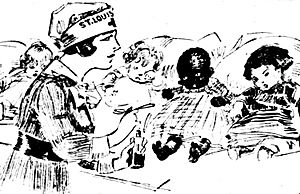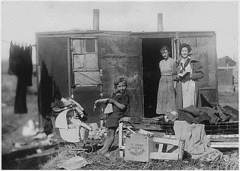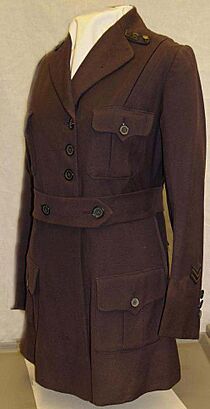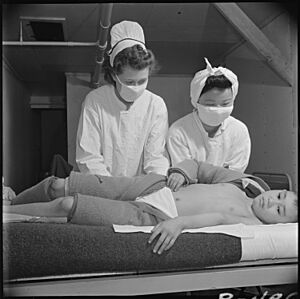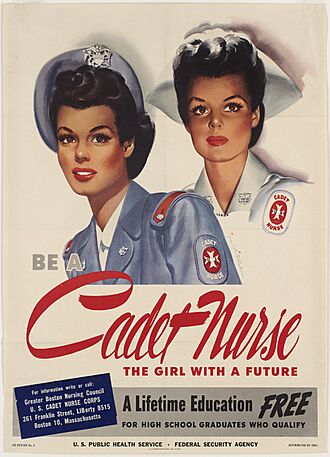History of nursing in the United States facts for kids
The history of nursing in the United States tells the story of how nursing became a respected and professional job in America, especially since the American Civil War.

Contents
Early Days of Nursing
Before the 1870s, many women working in hospitals were not trained. They often came from working-class families and were not highly respected by doctors or society. Nursing was seen as a simple household chore, like caring for sick family members.
But things started to change in the mid-1800s. People began to realize that trained nurses could do a much better job. Doctors started recommending nurses they trusted. Soon, caring for sick people at home became a regular paid job. By the 1880s, most nurses who finished hospital training schools went on to work in home care.
Nursing During the Civil War
During the American Civil War (1861–1865), nursing became very important. The United States Sanitary Commission, a government group, managed most of the medical care for the Union Army.
Dorothea Dix was a key leader. She helped convince the army that women could be great nurses. More than 20,000 women volunteered in hospitals for both the North and the South. They helped surgeons, gave medicines, fed patients, and kept things clean. They also cheered up soldiers, wrote letters for them, and comforted those who were dying.
- Helen L. Gilson was a famous nurse from Massachusetts. She managed supplies, dressed wounds, and cooked special meals for patients. She worked in hospitals after major battles like Antietam and Gettysburg. She was also a successful manager at a hospital for black soldiers in Virginia.
- Clara Barton became famous for her nursing during the war. She was a great organizer and later started the American Red Cross. This group mainly helps people during disasters, but it also supports nursing programs.
Many women in the South also helped with nursing, but their efforts were less organized. They often faced shortages of supplies.
Becoming a Professional Job
After the Civil War, nursing quickly became a professional career. Hospitals started their own nursing schools, following a model from Britain. These schools attracted smart women from different backgrounds.
- Linda Richards was America's first officially trained nurse. She graduated in 1873 from the New England Hospital for Women and Children in Boston.
- Isabel Hampton Robb helped make nursing a middle-class career. She directed the new Johns Hopkins School of Nursing. She wanted nurses to have advanced training, not just be low-paid workers.
After 1880, nursing schools improved their training. They used textbooks that taught nurses about modern medicine and scientific thinking.
However, in the early 1900s, hospitals started controlling nursing schools more. They used student nurses as cheap labor. By the late 1920s, there were many trained nurses, but also many untrained ones and other hospital workers.
Nurses began using new tools like thermometers and stethoscopes. They could even use X-ray machines and microscopes in some cases. This helped them gather more scientific information for doctors. However, nurses were not allowed to make medical diagnoses. Their main role was still to care for patients directly.
The University of Texas opened its School of Nursing in 1896. It was the first nursing school to be part of a university in Texas. Today, many nursing degrees are earned at community colleges and universities, not just hospital schools. This has helped nursing become an even more respected profession.

Hospitals Grow
Hospitals grew a lot in the late 1800s and early 1900s. People trusted hospitals more and could afford better care. The number of hospitals in the U.S. jumped from 149 in 1873 to 6,300 by 1933.
Most large hospitals had nursing schools. Young women trained there and often worked without pay. The number of trained nurses grew from 51,000 in 1910 to 700,000 by 1970. Hospitals were run by cities, states, churches, non-profit groups, and even doctors.
Religious Hospitals
Many religious groups in the U.S. built hospitals. These hospitals were often staffed by unpaid student nurses and some trained nurses.
- By 1915, the Catholic Church ran 541 hospitals, mostly staffed by nuns.
- Lutheran and Episcopal churches also started hospitals. They created groups of women called deaconesses who dedicated their lives to nursing.
- Methodists, a large Protestant group, also opened many hospitals starting in the 1880s. These hospitals served people of all faiths.
Public Health Nursing
After 1900, public health nursing became a new career path. Public health nurses worked to improve the health of whole communities, not just individual patients.
- The first public health nurse started in Los Angeles in 1898.
- By 1924, there were 12,000 public health nurses in the U.S.
Public health nurses helped with many things:
- They checked on health in schools.
- They provided care for pregnant mothers and babies.
- They dealt with diseases like tuberculosis.
The great 1918 flu pandemic showed how important nurses were. Doctors struggled to stop the illness, but nurses focused on caring for patients and helping them recover.
During the Great Depression (1929-1939), the government started many public health programs. This created more jobs for nurses.
- Dr. Sara Josephine Baker was a famous public health worker in New York City. She led teams of nurses into crowded neighborhoods like Hell's Kitchen. They taught mothers how to keep their babies healthy by showing them how to dress, feed, and bathe them.
- The Office of Indian Affairs also had a large nursing program. Nurses taught Native American women about hygiene and how to care for their infants.
Military Nursing
Nursing also played a big role in the military.
Spanish-American War (1898)
During the Spanish–American War, many soldiers got sick from diseases like yellow fever. The U.S. government asked women to volunteer as nurses. Over 1,500 women worked as contract nurses, including 250 Catholic nurses.
- Dr. Anita Newcomb McGee was in charge of choosing these nurses.
Professional Military Nurses
To make military nursing more professional, Congress created the Army Nurse Corps in 1901 and the Navy Nurse Corps in 1908. The Red Cross also became a key group for finding and assigning nurses.
World War I (1917-1918)
During World War I, about 20,000 registered nurses (all women) joined the military. More than 10,000 served overseas. They worked in military hospitals and ambulance companies.
- Key leaders included Jane Delano (Red Cross), Mary Adelaide Nutting (American Federation of Nurses), and Annie Warburton Goodrich (Army School of Nursing).
- The Army School of Nursing was created to train more nurses.
- Nurses were kept away from the front lines. Sadly, over 200 died from diseases, especially the Spanish flu.
After the war, Army Nurse Corps members received officer-like ranks. However, they did not get the same pay or full military status.
American Nurses Association
In 1911, the American Nurses' Association (ANA) was formed. It became the main organization for nurses in the U.S.
Later, in 1999, the United American Nurses (UAN) was created as a trade union for registered nurses. In 2009, it joined with other groups to form National Nurses United.
World War II (1939-1945)
Nursing changed a lot during World War II. Many nurses volunteered for military duty.
- About 59,000 women joined the Army Nurse Corps.
- About 18,000 joined the Navy Nurse Corps.
At first, the Red Cross chose the nurses, but as nurses gained higher ranks, they took more control. After the war, they also took more control of the ANA.
The military built many hospitals and used hundreds of thousands of enlisted men and women as nurses' aides. The government also started the Cadet Nurse Corps. This program paid for nursing schools to train 124,000 young civilian women, including 3,000 black women. The idea was for them to join the military nurse corps, but the war ended before they graduated.
Nurses were seen as heroes during the war. Hollywood movies showed them as brave and selfless. Most nurses stayed on the home front, but some served in dangerous places like the Pacific jungles.
President Franklin D. Roosevelt praised nurses in 1945. He even considered drafting nurses for the war effort, but it was not needed as the war ended.
Nursing After the War
After World War II, nursing faced a big question: Should nurses be mostly focused on technology and medical science, or on helping people with kindness?
Before the war, nurses were often controlled by doctors. But during the war, nurses gained leadership skills. They ran nurse corps and managed large operations. They learned how to make quick decisions and find new solutions.
After the war, these experienced nurses took charge of the American Nurses Association (ANA). They helped the ANA become racially integrated, welcoming black nurses. However, male nurses were still often excluded from nursing schools.
The ANA worked to get better pay and working conditions for nurses. In 1946, the average registered nurse earned about $1 an hour. Hospitals tried to stop nurses from forming unions.
Private duty nursing (caring for one patient at home) became less common after the Great Depression. Hospitals became better at providing round-the-clock care. They had the staff, skills, and equipment to treat sick people more efficiently.
Hospitals started hiring more trained nurses for permanent jobs. They also hired lower-paid aides and practical nurses to help with many tasks. This meant that registered nurses spent less time on basic chores and more time on studying and specialized care.
Nursing Since 1964
The Nurse Training Act of 1964 changed nursing education. It moved training from hospitals to universities and community colleges. This led to a big increase in the number of nurses. More women also stayed in the profession after getting married. Salaries went up, and nurses started specializing in different areas. Many nurses also took on administrative roles in hospitals and schools.
From 1965 to 1988, about 70,000 trained nurses moved to the U.S. for better-paying jobs. Most came from Asia, especially the Philippines. The Philippines had many nursing schools and trained nurses to work all over the world.
Even though nursing is still mostly a female profession, more men are becoming nurses. In 2019, about 12% of registered nurses were men, up from 2.7% in 1970.
Nurses sometimes get hurt at work, often when lifting patients. The Occupational Safety and Health Administration (OSHA) now recommends using machines to lift patients instead of manual lifting.
In 1998, nurse Fannie Gaston-Johansson became the first African American woman to become a full professor at Johns Hopkins University.
Images for kids
See also
- History of medicine in the United States
- Medicine in the American Civil War
- History of nursing


